- Blog
- Ecommerce Conversion Funnel: Everything You Need to Know to Optimize Your Funnel
Ecommerce Conversion Funnel: Everything You Need to Know to Optimize Your Funnel
-
Nikolett Lorincz
- Ecommerce
- 6 min read
Table of Contents
Struggling with low conversion rates on your ecommerce website? You’re not alone.
Many online business owners face this challenge, unsure how to guide website visitors smoothly from interest to purchase.
The ecommerce marketing funnel helps with exactly that. It describes how people transition from prospects to customers in an ecommerce store.
In this article, we’ll break down the ecommerce conversion funnel step-by-step, offering practical tips, real-world examples, and advanced strategies to optimize each stage.
By the end, you’ll have the tools and knowledge to transform casual browsers into loyal customers and drive your sales to new heights.
Let’s dive into the nitty-gritty of conversion funnel optimization!
What is an ecommerce funnel?
An ecommerce funnel (also called an ecommerce conversion funnel or ecommerce sales funnel) is a visual representation of the buyer’s journey from potential customer to paying customer.
It’s shaped like a funnel because fewer and fewer people will move through each progressive step.
Here’s the typical ecommerce sales funnel and the four stages:
- Awareness stage
- Consideration stage
- Purchase stage
- Retention stage
It starts with potential customers becoming aware of your ecommerce brand. It’s followed by them going to your ecommerce site and exploring product pages until they find something they like. Then, they complete the checkout process.
Customer retention is the final stage. Existing customers reenter the funnel again as they begin considering their next purchase.
The largest number of people will become aware of your brand through your team’s marketing efforts. However, increasingly smaller percentages will become site visitors, new customers, and repeat customers.
We can’t expect 100% of people to move from one stage to the next.
However, you can gather insights into customer behavior at each step. And it can rapidly (and consistently) increase your ecommerce conversion rate.
In effect, start the conversion funnel by targeting a larger consumer population, so you can maximize how many customers move from one stage to the next.
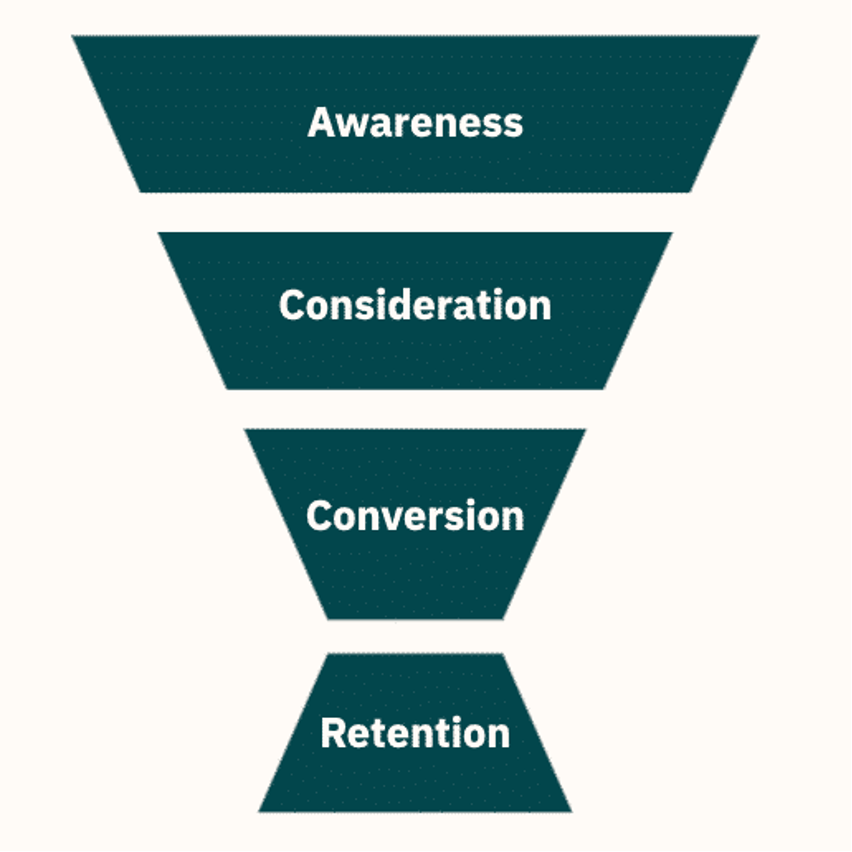
The 4 stages of the ecommerce sales funnel
Now, let’s discuss the four stages in more detail.
We’ll show you the different ways that prospective customers behave at each stage of an ecommerce conversion funnel.
Stage 1: Awareness
The first stage of the ecommerce conversion funnel is all about brand awareness. You should establish your online store as a valid option in your niche product categories.
Maximize traffic to your ecommerce business through both organic and paid channels. The better your marketing strategy, the healthier your ecommerce funnel will be from the start.
Understanding and targeting the right audience is crucial to ensure your content resonates with your target audience at all stages of the buyer’s journey.
Stage 2: Consideration
Relationship-building shines in this stage.
Your prospective customers go beyond mere awareness. They learn about your site and what makes it special. They also start to consider your product or service more seriously.
This stage is perhaps the most delicate. It requires a lead-nurturing strategy that gives site visitors time to browse through your sales pages at their own pace.
Pushing customers to buy right now in this stage probably won’t lead to more sales. They would likely just bounce because they are not ready yet.
The key here is to give them all the necessary information they need to move to the next stage.
Stage 3: Purchase
The purchase stage of the funnel directs customers to make those final few clicks.
You want them to go from your product pages to your checkout page and finish the purchase.
Conversion rate optimization (CRO) through A/B testing is crucial here to compare different methodologies and determine which generates more conversions and clicks.
Stage 4: Retention
The final stage of ecommerce funnel is all about turning your existing customers into loyal customers.
The linchpin of the retention stage is the post-checkout thank you page. This is where you have the opportunity to keep customers in the fold.
For example, you can invite them to follow your social media accounts or sign up for an email marketing newsletter.
3 examples of conversion funnel optimization
We’ve covered the four stages of the ecommerce conversion funnel.
Now, let’s examine 3 companies that figured out where to invest in their funnels to reap the greatest rewards.
1. SEMrush
SEMrush is a software company that helps ecommerce businesses and individuals with search engine optimization (SEO).
SEO is all about getting your website to show up on the results page when someone googles a relevant question or phrase.
For example, for a Chinese restaurant in New York City, good SEO means your business will show up at the top of the results when someone googles: ‘best NY Chinese restaurant.’
SEMrush conversion funnel starts with paid Facebook ads to reach potential customers.
These ads offer users access to free ebooks about SEO and digital marketing.
SEMrush focuses their efforts on the awareness stage by linking their social media ads and the future stages of their funnel.
They offer educational content that reinforces the need for their software. They’re also collecting names and emails at the same time.
Here’s a step-by-step breakdown of their strategy so you can leverage a sign-up form for your sales funnel goals, too:
- SEMrush collects email addresses and keeps in touch with their audience from the very first stage.
- They keep offering free resources via emails until their targets are ready to try out a demo.
- Eventually, users begin to pay for the service.
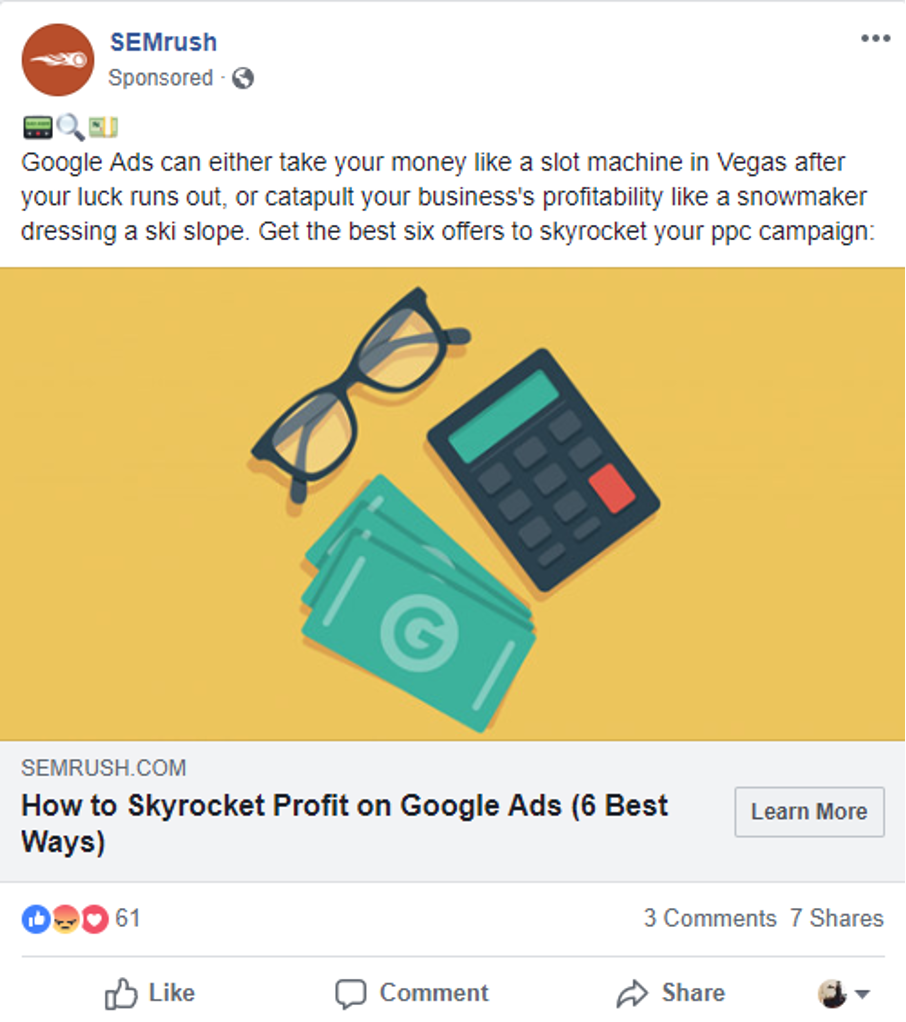
2. Swiss Watch Expo
Swiss Watch Expo sells pre-owned luxury watches. They had high incoming traffic, but the site’s owners were disappointed in their conversion rates.
Month after month, visitors spent lots of time looking at beautiful watches, but they rarely actually made a purchase.
It was time to optimize the purchase stage of their funnel and turn those window shoppers into paying customers.
So, they launched an OptiMonk popup to reduce cart abandonment.
They offered customers incentives like free shipping or $100 off their total purchase—if they completed their transaction within 15 minutes.
By increasing the urgency at the right time, Swiss Watch Expo created a more efficient sales funnel and increased their revenue by 25%.
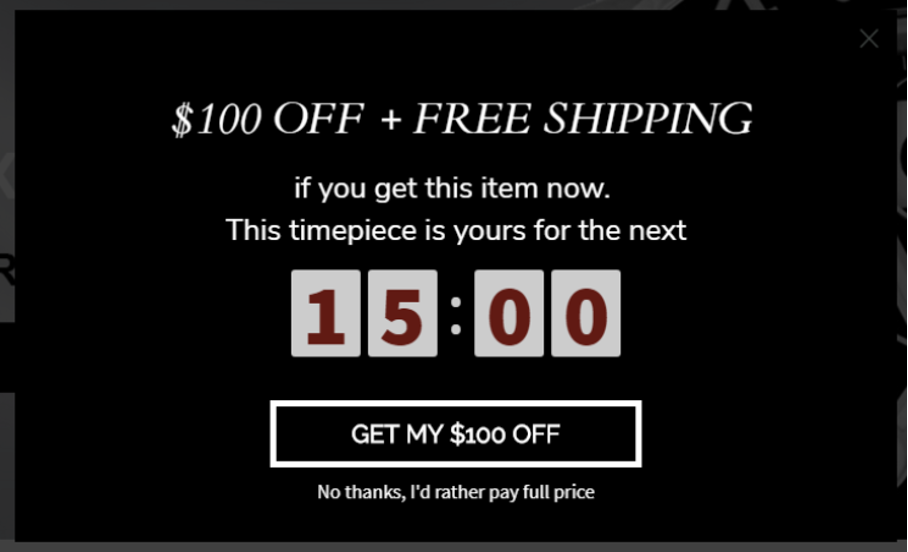
3. Away
Away is a luggage and travel brand that sells affordable, stylish products. The company’s marketing brings in lots of organic social media traffic, assisted by their aspirational lifestyle branding.
Away was unsatisfied with relying on a single channel, so they developed a referral program that simultaneously retained customers and brought in new leads.
They offered a $20 discount to both the referrer and the referee.
This kept a steady stream of high-quality leads entering Away’s ecommerce conversion funnel during the consideration stage.
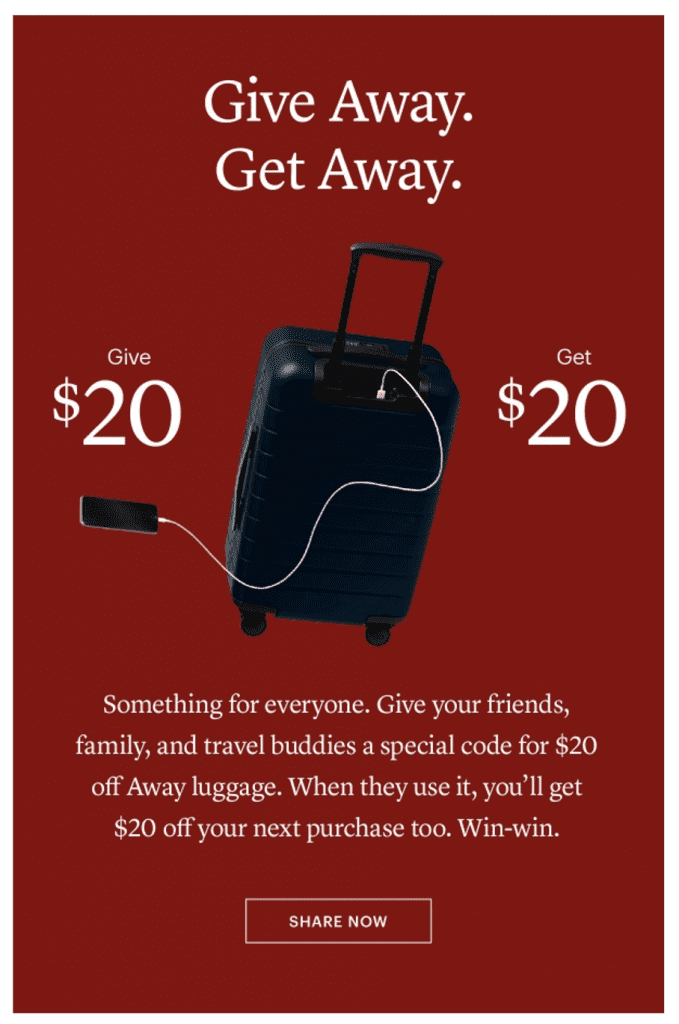
How to build an optimized ecommerce conversion funnel?
Now that you’ve seen some successful examples, we’ll show you how to create a unique sales funnel for your own ecommerce store.
Step 1: Understand your customer journey
It’s best if you fully understand your visitor’s buying journey before you create an ecommerce conversion funnel.
This means that you need a global understanding of how to market and operate your online store.
It’s a good idea to physically map out all the possible routes a customer can take from awareness to purchase and beyond.
Step 2: Identify key performance indicators (KPIs)
Once you have a visual representation of your customer journey, it’s time to start figuring out exactly where the leaks are.
Gather data on your:
- Traffic: See how many unique visitors come to your site from different channels.
- Bounce rate: The bounce rate is the percentage of visitors that leave the site after viewing just the landing page.
- Cart abandonment: The number of people who leave the site after putting items in the cart.
- Sales: The amount of revenue from sales.
- Conversion rate: The proportion of site visits that result in a sale.
You can investigate and detect where customers are exiting your marketing funnel. Then, you can see where to start formulating strategies to improve the funnel flow.
Step 3: A/B test everything
Once you’ve mapped out some optimization opportunities, it’s crucial to test out multiple versions of everything to find out what works best.
An analysis of your traffic might reveal that many people view your product pages but leave afterward. A confusing or unappealing interface could be one of the main reasons behind your missed conversions.
A/B testing is the process of trying out different versions of whatever solutions you might have. So, some candidate solutions for a(fictional) interface problem might be:
- making the buy button bigger
- changing the color
- including more pictures
You should develop each of these solutions and show different combinations to different customers.
After measuring the conversion rate of each candidate solution, you’ll have a great idea of what works and what doesn’t.
Companies often see huge jumps in conversion rates after A/B testing. Bear Mattress, for example, saw a 16.5% increase after A/B testing on their home page. Hubstaff and ISM eCompany increased their conversions by 49% and 27%, respectively.
Without A/B testing, it’s impossible to know whether your conversions are as high as they could be. Check out this guide for a detailed overview.

7 strategies to optimize your ecommerce conversion funnel
Now that we’ve had a bird’s eye view of the process of optimizing a conversion funnel, it’s time to get into some specifics.
If you’re having trouble coming up with ideas to optimize your sales funnel, here are some strategies. They’ll guide your prospective customers towards completing a purchase.
Awareness
Strategy #1: Content marketing
Producing content that consumers are interested in is a great way to bring in traffic. Provide real value to the people visiting your site by answering their important questions about your industry. Inputting time here will build a strong foundation for a long-lasting relationship.
Make sure not to neglect your SEO (Google Analytics is your friend for evaluating what’s working and what isn’t). Otherwise, nobody will find your great blog posts because they’re buried on the second or third results page.
With the right keywords, your content will shoot straight to the top.
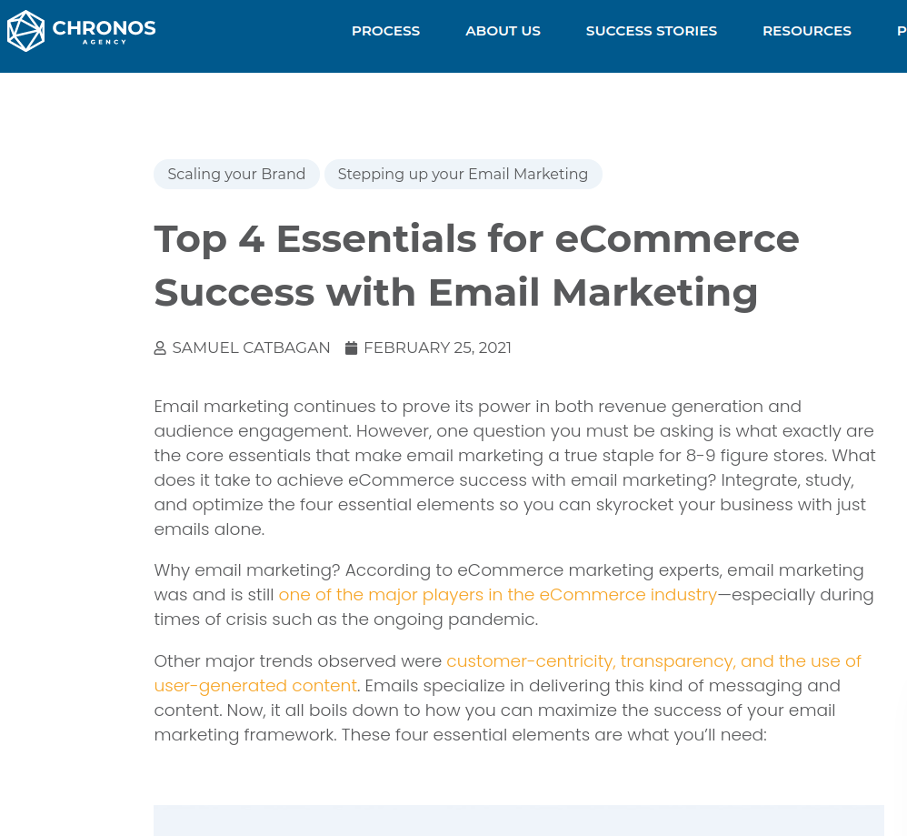
Strategy #2: Paid traffic
Investing in Facebook ads and other types of online advertising can ensure a steady stream of incoming traffic. However, it’s not always guaranteed.
Aim for a good Facebook ad that makes your value proposition crystal clear. This will attract those consumers with an actual interest in the types of products you sell. Make sure to A/B test your ads so they are as effective as possible.
Consideration
Strategy #1: Social proof
Putting online reviews and other user-generated content on your website helps build trust among your visitors.
It allows prospects to know what to expect from your products when they click “buy.”
And they won’t feel like they’re taking such a risk by buying an unseen product.

Strategy #2: Retargeting
Retargeting ads bring back visitors who left your site without buying anything. A well-timed email reminds visitors about your discounts and deals. It could save a purchase.
Purchase
Strategy #1: Well-designed checkout page
Make sure the checkout process is as easy as possible to ensure a good conversion rate.
Customers often abandon their carts when they’re confronted with an unclear checkout page or surprising shipping charges.
Tip: Make sure to offer multiple payment options, as you don’t want to lose a customer who only uses PayPal.
Strategy #2: Popups
Popups are one of the best ways to give shoppers that final push towards making a purchase. Especially, when getting the timing and frequency right.
Retention
Strategy #1: Loyalty programs
Create a program that rewards loyal shoppers with store credit or other perks to show them some appreciation and incentivize them to return. Make sure to provide real value. Consumers will see right through any smokescreens.
You can combine programs like these with a referral marketing campaign (just like we saw with Away).

The most important KPIs for your conversion funnel
To gain a comprehensive understanding of your funnel’s performance, it’s essential to measure various metrics.
Here are eight metrics that you should consider tracking:
- Conversion rate: This metric evaluates the percentage of total visitors who successfully convert into paying customers. To calculate this rate, divide the number of customers by the total or average website visitors.
- Click conversion rate: This metric assesses the click-through rate to conversion ratio. It measures the percentage of conversion clicks out of the total clicks. For instance, if you ran an Ad campaign with 1000 clicks and achieved 100 customers, your click conversion rate would be 10%.
- Cart abandonment rate: This metric measures the rate at which visitors leave your site without completing a purchase. It specifically focuses on customers who add items to their cart but fail to finalize the checkout process. Calculate this rate by dividing the number of completed checkouts by the total checkouts initiated, multiplied by 100%.
- Add to cart rate: This metric quantifies the percentage of visitors who add items to their cart. It can be calculated by dividing the number of add-to-carts by the total number of visitors.
- Customer lifetime value: This metric determines the value of each customer or the total amount they have spent on your store to date. It involves calculating factors such as average customer lifetime, average monthly spend, and % gross margins.
- Average order value: This metric provides insights into the average amount of money a customer spends on your store per transaction. To calculate this, divide the total revenue by the number of checkouts.
- Repurchase rate: This metric gauges the loyalty and repeat purchases of your customers. It measures the percentage of customers who made multiple purchases within a specific period, divided by the total number of customers in that period.
- Returns: This metric tracks the percentage of orders that are returned. Compute this rate by dividing the number of return requests by the total number of orders fulfilled.
By regularly monitoring and analyzing these metrics, you can gain valuable insights into the performance of your funnel and make data-driven decisions to optimize your sales and conversions.
How to identify drop-offs in your conversion funnel analytics?
To identify drop-offs in your conversion funnel analytics, follow these steps:
- Access your GA4 account and navigate to the “Reports” section.
- Look for the “Monetization” category and select the “Checkout Journey Report”. This report focuses on four essential GA4 events: begin_checkout, add_shipping_info, add_payment_info, and purchase. It also provides insights based on dimensions such as device, country, region, and language.
- Additionally, explore the “Purchase Journey Report” found under the “Monetization” category. This report analyzes five events: session_start, view_item, add_to_cart, begin_checkout, and purchase.
- Analyze both reports in detail to understand where potential customers drop off in your conversion funnel.
- Look for patterns or trends in the data that reveal specific stages where customers are more likely to abandon the conversion process.
- Focus on the events associated with drop-offs and investigate possible factors contributing to this behavior.
- Make use of the available dimensions in the reports, such as device or location, to identify any patterns or differences that might be influencing drop-offs.
- Use the insights gained from this analysis to refine and optimize your conversion funnel, targeting the areas where drop-offs are occurring.
- Continuously monitor and track your conversion funnel analytics, making adjustments whenever necessary based on the data and insights obtained.
By carefully analyzing these reports and events, you will be able to identify drop-offs in your conversion funnel and gain valuable insights to improve your overall conversion funnel analytics.
Final thoughts
Figuring out your ecommerce conversion funnel can be a great feeling. There’s that moment when it clicks, and you’ll start to really see your users moving down your funnel towards a conversion.
Getting to that point takes a lot of introspection and research. Get into the mindset of your customer at each stage of the funnel and detect what changes will move them along. After that, there are lots of tweaks and redesigns and, of course, A/B testing.
All that hard work is for the sake of creating and maintaining a relationship with your customers. It’s a process that starts with awareness and ends with a thank you page.
That is until they start considering their next purchase and reenter the funnel.
We hope that you found this ecommerce conversion funnel article helpful. Let us know how you optimize your sales funnel.
Migration has never been easier
We made switching a no-brainer with our free, white-glove onboarding service so you can get started in the blink of an eye.

What should you do next?
Thanks for reading till the end. Here are 4 ways we can help you grow your business:
Boost conversions with proven use cases
Explore our Use Case Library, filled with actionable personalization examples and step-by-step guides to unlock your website's full potential. Check out Use Case Library
Create a free OptiMonk account
Create a free OptiMonk account and easily get started with popups and conversion rate optimization. Get OptiMonk free
Get advice from a CRO expert
Schedule a personalized discovery call with one of our experts to explore how OptiMonk can help you grow your business. Book a demo
Join our weekly newsletter
Real CRO insights & marketing tips. No fluff. Straight to your inbox. Subscribe now
Nikolett Lorincz
- Posted in
- Ecommerce
Partner with us
- © OptiMonk. All rights reserved!
- Terms of Use
- Privacy Policy
- Cookie Policy
Product updates: January Release 2025








